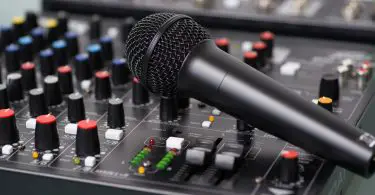The Top Unpowered Mixers for Beginners
Digital mixers have become the standard for many venues, touring acts, and bands because they offer recall, onboard processing, compactness, lightweight, ease of use, and many options with many different features.
As musicians require more power in their live performances, it is harder to rely completely on a live-powered mixer. As an engineer, you have less accessibility, less power, and fewer options. Alternatively, live sound unpowered mixers can provide all three of these features.
The three most important factors to consider when buying a mixer are:
- Number of inputs and outputs required
- Types of inputs needed
- Additional features required (e.g. built-in effects or USB connectivity)
Integrating unpowered live sound mixers into your audio equipment allows you to maintain the highest power and quality levels for your clients. Or, if you are a musician, it will provide the highest level of accessibility and customization for your performances.
-
 Check on Amazon Search Used
Check on Amazon Search UsedThe features on this unpowered mixer are unmatched. With four groups, you can easily sequester each instrument to their own group, giving you easy processing and manipulation capabilities.
-
 $1,599.99Check on Amazon Search Used
$1,599.99Check on Amazon Search UsedAllows for USB integration, provides EQ on both stereo and mono channels, can playback audio at +21dBu.
06/28/2025 05:05 pm GMT -
 $599.00Check on Amazon Search Used
$599.00Check on Amazon Search UsedPhantom power, an option pad switch, EQ and HP filters, sends, and groups.
06/29/2025 02:08 am GMT -
 $315.38Check on Amazon Search Used
$315.38Check on Amazon Search UsedA clear audio signal rivaling mic preamps in consoles worth several thousands of dollars.
06/28/2025 07:04 pm GMT -
-
-
 $599.99Check on Amazon Search Used
$599.99Check on Amazon Search UsedVertically mounted circuitry makes this console more robust and durable than any of the consoles above.
06/29/2025 03:09 am GMT
Our Process
The author of this list of reviews is currently a student studying audio technology (B.S) at a top school in the United States for audio production. Apart from their studies, they have worked on various audio applications. They range from circuitry planning for microphones, digital audio signal processing software, and reactive audio signal processing.
Also, the author utilizes the state-of-the-art studio at their school to record, mix, master and produce several records each year. I have worked as a live monitor engineer at two venues, assisting both audio engineers and musicians alike with various tasks and troubleshooting situations. I’ve learned how every type of audio equipment interacts with one another, though I am always continuing to learn how to optimize entire audio systems.
What is a Live Sound Mixer?
A live sound mixer is a crucial part of any serious music performer’s arsenal of equipment. Whether you own the system or one of your employees owns the system, it is vital to your live performance to be familiar with your live sound setup. If you don’t have the time or expertise, hire a professional who is familiar with your live sound setup.
A live sound mixer is a system that converts, manipulates and effects an audio signal before it reaches the live sound monitors. A mixer allows you to integrate as many audio signals as the machine allows into one cohesive, non-distorted, peaked audio image. You can manipulate the audio levels depending on certain parameters.
And you can do so the moment you are in your song or for any other reason you may need to make a change.
I could list the specifications and components before purchasing live sound unpowered mixers. However, the first step is to decide if an unpowered mixer is right for your situation.
Live Sound Powered Vs. Live Sound Unpowered Mixers
There are two main types of mixers on the market: unpowered and powered. Both serve a specific subset of purposes, so read on to learn which would be best for your needs.
The Purpose of Live Sound Unpowered Mixers
Live sound unpowered mixers are usually lightweight. This is because they contain fewer components and features than live sound unpowered mixers. Powered mixers contain an amplifier within the mixer, making the machine highly mobile, but it can be heavier. Powered mixer manufacturers usually market them towards gigging musicians or audio engineers who have just started their careers.
They also gear them towards those who need a backup machine in case of emergencies. High-end machines give medium-to-high-end unpowered mixers a run for their money. However powered mixers are less desirable for a musician playing in a theater or arena setting.
All About Live Sound Unpowered Mixers
Live sound unpowered mixers utilize an external amplifier. They provide more room for engineers to extend the capability of the machine. Unpowered mixers are for musician who maintain the highest standards for their live shows. They also work well for audio engineers who wish to provide the utmost in power to their clients.
Also, unpowered sound mixers come with more features and effects. Most people think they are lighter than powered mixers. However, when you include an amplifier in your calculations, the unpowered mixer could be heavier.
Analog Vs. Digital Live Sound Mixers
Before the advent of Avid’s Pro Tools and the mass adoption of mixer technology, many professional audio engineers used analog mixers. In fact, prior to Pro Tools, a digital mixer would have been impossible. This is because you couldn’t process audio at a rate that would make a good experience. As technology developed, the audio community’s discussion between analog and digital mixing has become highly polarized.
Why You Should Choose a Digital Mixer
Digital mixers are the future. Although analog has sporadically become popular, it has receded into obscurity for most engineers. The invention of digital mixers has made the job of an audio engineer easier. Also, it allows for seamless integration between the studio and live setting.
In the studio, an engineer can create increasingly complicated signal paths. That way, they can reshape audio signals originally played and recorded with analog transducers.
You can contact the studio engineer to send you the signal path when utilizing a digital signal. Of course, the means of transfer is different depending on the manufacturer and plugins you use. However, your live mix will be much closer to the original track.
Why You Should Choose an Analog Mixer
The audio you get from an analog medium is hard to replicate in the digital world. Instead of dealing with the zeros and ones of computer language, you use circuitry and electrons to produce an audio signal. Many audio engineers prefer this method because it creates a warmer, more vintage, distinct tone for their musicians.
The only downside to this type of mixer is the lack of accessibility and manipulation from the mixer itself. Alternatively, if you are educated in the sciences of electrical engineering, you can modify, enhance, or completely change the entire system. But this only works if you maintain a high standard of modification.
Determining How Many Inputs and Outputs You Need
A live mixer is hard to get right the first time. As a musician, your demands could be different in two to three years based on your new music or employment. Because of this, it is hard to make a purchase today that will suit you for many years to come, especially in a live setting. Therefore, it is important to be objective when choosing a live mixer.
You want one of the live sound unpowered mixers that will have enough inputs for your current music as well as the music you will create in the future. Based on these requirements, pay attention to the amount of mic/line inputs and stereo inputs. Also think about whether your mixer provides phantom power to some, all, or none of the inputs. Many contemporary mixers provide phantom power to line level inputs, but other mixers will provide it for the stereo inputs.
Inputs and Outputs: Compatibility Concerns of live Sound Unpowered Mixers
Compatibility is important when it comes to live sound unpowered mixers. If you are building an entire live sound network, purchasing the right mixer with the wrong monitors will leave you in a tough predicament at your first show. For these reasons, be wary of what monitor types, brands, or specifications you need for your live sound unpowered mixer.
Buses, Sends and Signal Chains
Music is evolving into a more complex art form as the audio industry creates higher-powered systems. For this reason, it is vital to pay close attention to the capability of your product choice in handling signal chains. Many live sound unpowered mixers follow the “what you see is what you get” model. This is where you have inputs and outputs without any level of audio signal processing.
This form of a mixer is completely accessible and maintains the ability to complete multiple shows. However, if you incorporate effects, dynamics processing, and other components into your music that require more than simple in and out audio, be wary.
Alternatively, there are many digital mixers that include buses, sends and modifiable signal chains that can do almost as much or more signal processing than the best studio mixers. Live sound mixers such as these include an assortment of effects like reverbs, compression, choruses, delays, vocoders and phasers. So they can help you minimize the amount of equipment you require while on tour.
Monitor or Auxiliary Busses
An important thing to note is the integration of monitor and auxiliary buses. Larger, more expensive monitors will include these features. They allow every band member to affect their playback levels personally. This is an important feature for many musicians because it can diminish their reliance on a monitor engineer or front-of-house engineer.
This feature gives you full domain over the important aspects of each song. If you plan to record any of your live performances, use these features to send the audio mix to a third-party recording device. This allows you to sync professional audio with any visual material.
Peak and Meter Monitoring
In the old days, audio engineers had to listen closely to hear whether a band’s audio was clipping or not. Nowadays, peak and meter monitors give this information depending on the signal coming in and leaving the board.
Unfortunately, this technology is not universal in live sound unpowered mixers. In fact, it is often missing from many lower-tier mixers. Although it is not crucial, this feature will greatly help you or your engineer ensure that the band’s levels are consistent and not distorted or clipped.
Insertion or Direct Output Features
This feature is primarily available on live sound unpowered mixers due to the lack of an internal amplifier. The insertion or direct output feature provides a higher level of customization in comparison to live sound powered mixers. An insertion or I/O feature is different than the number of inserts on a mixer.
In fact, the I/O allows you to connect outboard processing gear or further audio effects. For example, you can connect an outboard compressor, a noise gate, or another mixer with direct outputs for each specific channel.
Top Pick: The Allen & Heath GL2400-32

Credit: Allen & Heath Limited
After considering all these features, the prime candidate for the best live sound unpowered mixer is the Allen & Heath GL2400-32 live console. The board features 32 inputs with optional phantom power on each individual track with four groups. It also has six aux inputs, left and right mixes, multi-source stereo channels and aux-fed sub-capabilities.
The features on this unpowered mixer are unmatched. With four groups, you can easily sequester each instrument to their own group, giving you easy processing and manipulation capabilities.
In short, this mixing console comes with an incredible number of features, allowing you to use this console for the rest of your career if you want. The features of these live sound unpowered mixers are unmatched in comparison to many contemporary models. With four groups, you can easily sequester each instrument to their own group. This provide easy processing and manipulation capabilities. This feature is suitable for those who are a part of a four-piece band.
Why You Get a High Level of Customization with the GL2400-32
The six aux inputs offer a high level of customization. You can record the performance, send monitoring capabilities to each of the four band members and use another input for an external processor. The left and right mix function let you control where each instrument “lives” in the audio playback. Many engineers like to use this to create a “bigger” sound from the perspective of the audience.
The multi-source stereo channel lets you create a stereo channel using two different sources, or the same source. And this can create interesting sounds in your performance. The aux-fed sub capability can help you enhance sub and lower frequencies during your performance. This feature can distinguish your performance if you have a DJ or bassist.
The Allen & Heath board provides many features. Some more notable capabilities are the assignable talkback function and balanced XLR outputs with +26dBu drive. It has an optional internal power supply, making it both powered and unpowered depending on your needs. It also comes with a backup supply, 4-band sweep EQ and 100 Hz HP filters. And you also get visual metering and a 1kHz oscillator. Other outstanding features include a pink noise generator, low noise floor and console linking.
All the features allow you to use this console as either a live console or as a studio console because of its headphone and local monitor output capability. Unfortunately, this brand of live sound unpowered mixers is usually priced between $2,400 to $3,000. However, if you are looking for a machine to last you the rest of your career, this is a small price to pay for such longevity and versatility.
Runner-Up: Mackie VLZ4 Series Mixer

Finding the best of the live sound unpowered mixers was not easy with all the processing capabilities on the market. But the runner-up is the Mackie VLZ4 Series Mixer for a variety of reasons. The most important reason for choosing this runner-up console is the price. At about half the cost of the Allen & Heath, you receive a huge level of processing capabilities.
Allows for USB integration, provides EQ on both stereo and mono channels, can playback audio at +21dBu.
The Mackie console allows for USB integration. It also provides EQ on both stereo and mono channels and can playback audio at +21dBu. The preamps on this console are second to none, providing for a great audio signal playback. Unfortunately, this console does not provide the extensive features that the Allen & Heath does. This includes LR power, buses, sends and aux capabilities.
However, the Mackie automatically routes odd channels to the left and even channels to the right. All channels are assigned to the main mix and the board provides 20Hz-20kHz bandwidth. Both of these live sound unpowered mixer boards can serve any musician as long as you don’t need more than 24 or 32 inputs.
Honorable Mentions
Yamaha MG16XU

Credit: Yamaha Corporation
The Yamaha MG16XU is one of the most affordable live sound unpowered mixers for the beginner musician or show promoter. With 16 inputs, the user of this console can provide audio playback for smaller venues.
Phantom power, an option pad switch, EQ and HP filters, sends, and groups.
The Yamaha console provides phantom power and an optional pad switch. It also comes with EQ and HP filters, sends and groups. They’ve packed all these features into a small USB-powered mixer. This is one of the best live sound unpowered mixers for a gigging musician who sets up their own audio system or a gigging duo.
Pros
- Portable
- Powerful for the price
- Aux sends, groups, and effects
Cons
- USB powered so it might be slower than desired
- One onboard compressor
The Behringer Xenyx X2222

Credit: BEHRINGER
Like the Yamaha console, the Behringer Xenyx X2222 is powered by an external USB cable. The Xenyx line of live sound unpowered mixing consoles all contain the same mic preamps, which many club audio engineers consider a great value. These mic preamps produce a clear audio signal that rival mic preamps in consoles worth several thousands of dollars.
A clear audio signal rivaling mic preamps in consoles worth several thousands of dollars.
The Behringer X2222 is one of the analog live sound unpowered mixers that maintain several effects, EQs, and one knob compressor. These features offer flexibility in your signal processing. The only downside is that the USB power can make it slow.
Pros
- Great value for your buck
- Amazing preamps
- Ultra-low noise floor
Avid S6

The creators of Pro Tools decided to enter into the live sound market with a seamless studio-to-live system. This console is for the gig, company or professional audio engineer. In the price range of $20,000 to $25,000, this is not for the average hobbyist. The S6-M10 is one of the live sound unpowered mixers primarily for in studio applications.
The 9:30 Club in Washington DC uses the M10 8-5 console as their primary live console. In fact, Rolling Stone Magazine has named the 9:30 Club as the best venue in the United States.
Pros
- Ultimate studio and live sound mixer
- Seamless studio to live system
- Multi-platform accessibility
Cons
- Expensive
- Primarily focuses on Avid products
Alto Live 2404 24-Channel Mixer

Credit: inMusic Brands, Inc
The Alto Live 2404 mixer is an efficient budget mixer or backup mixer for any audio engineer or musician. With four buses and onboard DSP, this mixer can meet most requirements necessary for a live performance. You can use the 2404 as a USB audio interface if you desire a 2-in-1 experience.
Great budget mixer or backup mixer for any audio engineer or musician.
Alesis, a company that created quality beginner to intermediate electronic audio equipment creates the DSP effects. The Alto Live 2404 is one of the most affordable live sound unpowered mixers, costing between $500 and $600.
Pros
- 2-in-1 mixer
- 24 analog inputs
- Portable: only 18 pounds
Cons
- Alesis DSP can be low quality depending on the effect
- No automation capabilities
Allen & Heath ZED-14 USB Mixing Console

Credit: Allen & Heath Limited
Like many of the previous consoles, this Allen & Heath console utilizes USB as a connection to appeal to beginners and intermediate users. However, this does not take away from the power and accessibility provided by this machine. The A&H Zed utilizes vertically mounted circuitry. This makes it more robust and durable than most consoles, aside from the Avid S6.
Vertically mounted circuitry makes this console more robust and durable than any of the consoles above.
The A&H console provides phantom power, six mono channels and four stereo channels. It also has four aux sends and two stereo returns. It includes the DAW Sonar LE by Cakewalk. The only con is the USB power could slow it down.
Pros
- 2-in-1 console
- Powerful for the price
- Incredibly durable
These are the top live sound unpowered mixers for quality accessibility and customization. Have you chosen your favorite? It shouldn’t be hard if you consider your needs, budget and future goals as a musician.










Start the discussion at talk.hearthemusicplay.com